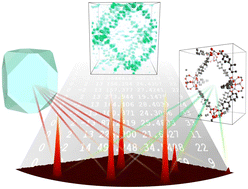We are delighted to introduce Tutorial Reviews as a new article type in CrystEngComm
CrystEngComm Tutorial Reviews were first commissioned in 2024 and are aimed at researchers who are new to the field or are embarking on a new direction of research, giving insight into how crystal engineering techniques underpin certain research areas.
They are focused on the application of crystal engineering techniques and should be comprehensive enough to be used for teaching purposes. They comment on best practice techniques for a given research methodology and how understanding crystal engineering can best serve researchers’ progress on a given topic.
Each Tutorial Review will include up to five ‘key learning points’ that a reader should expect to gain from reading the review.
See our most recent Tutorial Review by Stefano Canossa from ETH Zürich
| Useful practices in single crystal diffraction analysis of reticular structures
Stefano Canossa
CrystEngComm, 2025, 27, 6556-6571 |
 |
Key learning points in this Tutorial review:
1. Crystal structures are artificial simplifications of the non-periodic structure of real crystals. Nonetheless, these models are key enablers of scientific progress, if they maintain accuracy before precision in describing the average structure.
2. Steps such as sample preparation, data collection, data reduction, and structure modelling should be based on educated intentional choices. Default options provided by software or pre-made routines can be accepted only when their significance has been understood in the appropriate context.
3. Models can be only as reliable as the data allows for, and data can be only as good as the crystal allows for. Investing adequate care firstly on crystal selection, then on data collection and reduction, and ultimately on structure modelling, is a defining aspect of a crystallographer’s work.
4. The distinction between ‘data’, ‘information’ and ‘model’ — herewith provided — is necessary for a correct crystallographic practice and a scientifically rigorous representation of its results.
5. Standard diffraction data provide a wealth of information beyond the simple numerical values of integrated intensities. This information can be found in reciprocal space reconstructions and include aspects such as mosaicity, disorder, and defects.
Meet the author
 |
Stefano Canossa is a senior scientist with over a decade of experience in the crystallographic analysis of open-framework compounds using X-ray and electron diffraction. Trained as a coordination chemist, his crystallographic journey began during his MSc research on host–guest chemistry in metal–organic frameworks, and later expanded to include co-crystals, metal complexes, zeolites, and perovskites. Alongside crystal structure determination, his independent research explores the synthesis and characterization of correlated disorder in crystalline materials by leveraging on single crystal total scattering analysis in both real and reciprocal space. |
Tutorial Reviews are normally invited by the Editorial Board, however suggestions are welcome and enquiries, along with a brief synopsis and author credentials, should be directed to the Editors-in-Chief at CrystEngComm-rsc@rsc.org. Readers may nominate themselves, or others, to write a Tutorial Review.
We hope you enjoy reading this Tutorial review and keep an eye out for the next one in the series coming soon: Identifying and Characterising Flexible Crystals by Jack Clegg and colleagues.










